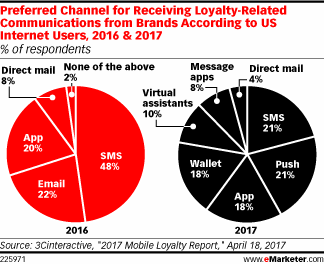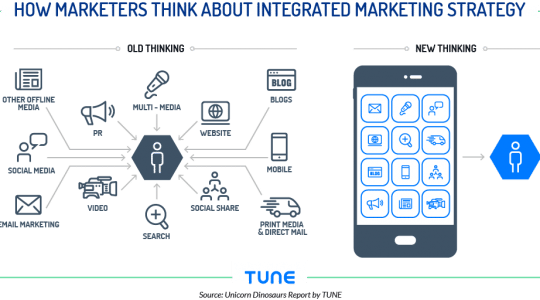
It’s a familiar story: brands need to manage omnichannel communications. Marketers have heard this message since email, the web, and social media marketing were new. But now, there are three key differences.

eMarketer data on customer contact preferences in loyalty programs
- Massive expansion of available channels
- Rapid consumer acceptance of new channels
- Incredible diversification of customer channel preferences
All three of those are visible in a new eMarketer report that landed yesterday, proclaiming that The Best Way to Contact Users Is Every Way.
In 2016, three channels — SMS, email, and app — covered 90% of how loyalty club members preferred to be contacted. In one short year customer behavior has changed so drastically that it now takes six separate channels to match that same 90% chunk of customer behavior.
And those six contain a hefty slice of the new, the leading edge, and the bleeding edge:
- SMS
- Push messages (in apps)
- In-app messages (yes, in apps)
- Digital wallets (e.g., Passbook)
- Virtual assistants (e.g., Alexa, Google Assistant, Siri, Cortana)
- Messaging apps (think bots and human-powered messages in Facebook Messenger, Kik, and other platforms)
Here’s the kicker though: the customers who want to be contacted via Alexa are not the same people who still want email or — yes, it still exists — direct mail. And those who want a coupon in Passbook may not have your app, which is why they’re not the same people as those you can connect with via push messaging or in-app messages.
The question for marketers is obvious: how do you manage such diversity?
Marketers clearly need tools that manage the in-app experience. They also clearly need a people-centric marketing system of record that helps them both understand where customers are in the buying journey, and maintain state so that future interactions are contextualized in that funnel or stream.
Something that, in other words, helps them not suggest a customer buy a service that she just purchased an hour ago. And that helps a customer service agent know what a prospect has been looking for for the past three weeks.
So, yes, you need to be omnichannel. But each prospect likely only cares about two or three channels. Managing that complexity can be simple, but only with the right technology.
Keep an eye on TUNE for exactly that.
Author
Before acting as a mobile economist for TUNE, John built the VB Insight research team at VentureBeat and managed teams creating software for partners like Intel and Disney. In addition, he led technical teams, built social sites and mobile apps, and consulted on mobile, social, and IoT. In 2014, he was named to Folio's top 100 of the media industry's "most innovative entrepreneurs and market shaker-uppers." John lives in British Columbia, Canada with his family, where he coaches baseball and hockey, though not at the same time.




Leave a Reply
You must be logged in to post a comment.